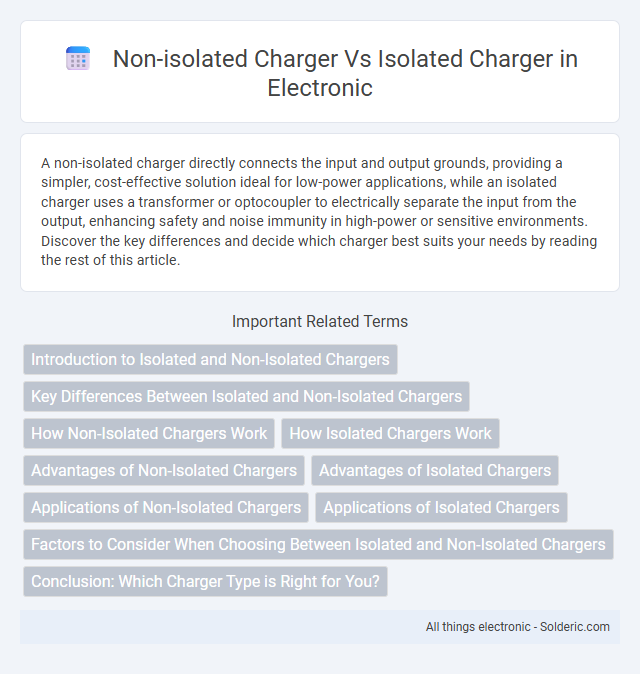A non-isolated charger directly connects the input and output grounds, providing a simpler, cost-effective solution ideal for low-power applications, while an isolated charger uses a transformer or optocoupler to electrically separate the input from the output, enhancing safety and noise immunity in high-power or sensitive environments. Discover the key differences and decide which charger best suits your needs by reading the rest of this article.
Comparison Table
| Feature | Non-Isolated Charger | Isolated Charger |
|---|---|---|
| Electrical Isolation | No galvanic isolation between input and output | Provides galvanic isolation for safety and noise reduction |
| Safety | Lower safety level; risk of electric shock | Higher safety due to isolation barrier |
| EMI/RFI Noise | Higher electromagnetic interference and noise | Reduced EMI/RFI for sensitive applications |
| Cost | Generally lower cost | Higher cost due to additional components |
| Complexity | Simpler design and smaller size | More complex with extra isolation components |
| Common Applications | Low-voltage, low-cost devices like USB chargers | Industrial equipment, medical devices, and high-voltage systems |
| Efficiency | Typically higher efficiency due to less components | Slightly lower efficiency due to isolation transformer losses |
Introduction to Isolated and Non-Isolated Chargers
Isolated chargers use transformers or optocouplers to provide galvanic isolation, ensuring safety and noise reduction by separating the input and output grounds. Non-isolated chargers rely on direct electrical connections between input and output, resulting in simpler, smaller, and more cost-effective designs but with potential safety risks and noise interference. The choice between isolated and non-isolated chargers depends on application requirements such as voltage levels, safety standards, and electromagnetic compatibility.
Key Differences Between Isolated and Non-Isolated Chargers
Isolated chargers provide galvanic isolation between the input and output, enhancing safety and reducing electrical noise, which is essential for sensitive electronics and medical devices. Non-isolated chargers lack this isolation, offering simpler designs with higher efficiency and lower cost but potentially increased risk of electrical interference and safety concerns. The choice depends on the application's safety requirements, electromagnetic interference tolerance, and cost constraints.
How Non-Isolated Chargers Work
Non-isolated chargers operate by directly connecting the input power source to the output circuit without a galvanic barrier, enabling simpler designs and higher efficiency in power transfer. They typically use buck, boost, or buck-boost converters for voltage regulation, relying on high-frequency switching to maintain stable output voltage suitable for battery charging. The absence of isolation means these chargers are best suited for applications where safety isolation is not a critical requirement, optimizing cost and size in consumer electronics.
How Isolated Chargers Work
Isolated chargers utilize a transformer to separate the input power source from the output, ensuring electrical isolation and enhanced safety. This design prevents direct electrical connection between the supply and the load, reducing the risk of electric shock and minimizing noise interference. The isolation barrier also enables the charger to handle higher voltages and comply with stringent safety standards in medical, industrial, and telecom applications.
Advantages of Non-Isolated Chargers
Non-isolated chargers offer higher efficiency and lower cost due to their simpler design, which eliminates the need for transformers or additional isolation components. These chargers are typically smaller and more compact, making them ideal for portable devices and applications where space is limited. Your choice of a non-isolated charger supports faster signal transmission and reduced energy loss, enhancing overall performance in low-voltage systems.
Advantages of Isolated Chargers
Isolated chargers provide enhanced safety by using galvanic isolation to separate the input and output, preventing electrical shock and reducing the risk of short circuits. They offer superior noise immunity and improved signal integrity, making them ideal for sensitive electronics and industrial applications. Compliance with international safety standards is more easily achieved with isolated chargers, ensuring reliable performance in demanding environments.
Applications of Non-Isolated Chargers
Non-isolated chargers are predominantly used in applications where low voltage and cost efficiency are critical, such as in USB-powered devices, portable electronics, and battery-operated tools. Their simple design, which lacks galvanic isolation between input and output, makes them ideal for compact, lightweight consumer products requiring direct connection to the power source. These chargers excel in scenarios with minimal electrical noise and safety constraints, including power banks, mobile phones, and small household gadgets.
Applications of Isolated Chargers
Isolated chargers are predominantly used in applications requiring enhanced safety and electrical noise reduction, such as medical devices, industrial control systems, and electric vehicles. Their galvanic isolation protects sensitive electronics and users from high-voltage surges and ground faults. This makes isolated chargers essential in environments where stringent safety standards and reliable power conversion are critical.
Factors to Consider When Choosing Between Isolated and Non-Isolated Chargers
When choosing between isolated and non-isolated chargers, consider factors such as safety requirements, electromagnetic interference (EMI) levels, and system complexity. Isolated chargers provide galvanic isolation, enhancing user protection and minimizing noise in sensitive applications, whereas non-isolated chargers offer simpler design and higher efficiency but with limited safety isolation. Cost, size constraints, and compliance with industry standards like IEC 60950 also play critical roles in selecting the appropriate charger.
Conclusion: Which Charger Type is Right for You?
Non-isolated chargers offer compact design and cost efficiency, ideal for low-power applications where space and budget are priorities, while isolated chargers provide enhanced safety and noise immunity, essential for industrial or medical environments requiring strict electrical isolation. Choosing between non-isolated and isolated chargers depends on specific needs such as voltage isolation requirements, application criticality, and regulatory compliance. Evaluating power levels, safety standards, and interference concerns will guide users to the optimal charger type for their device or system.
Non-isolated charger vs isolated charger Infographic

 solderic.com
solderic.com